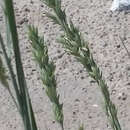en
names in breadcrumbs


Panicum amarum, commonly known as bitter panicum, bitter panicgrass, bitter switch grass or running beachgrass, is a perennial, warm-season dune grass native to coastal regions along the Gulf Coast of the United States and northeastern Mexico.Several subspecies occur along the US Atlantic coast as far north as Connecticut and Rhode Island; one of these, P. a. amarum, is native and state-listed as threatened.Panicum amarum is also found in the lower Midwestern US and been introduced to inland locations in North Carolina, West Virginia and New Mexico, the Bahamas and Cuba.
Bitter panicum grows in robust clumps, with thick, smooth, bluish leaves up to 50 cm (20 inches) long.Relatively long-lived (20+ years), P. amarum reaches a maximum stem height of about 2.5 meters (7.5 feet) at maturity, and grows variously upright or close to the ground (prostate).Blooming in late summer and fall, it produces clusters of low quality seed, but it reproduces mostly by vegetative sprouting along underground rhizomes.
In its native range, bitter panicum grows on coastal dunes, usually in the foredune slopes (closest to the ocean) where windblown sand accumulates.Tolerant of the harsh features of this environment: salt spray, inundation, storm surges, burial by drifting sand such that almost none of the plant is exposed, and high temperatures, it is one of the first colonizers in dune ecosystems.While P. amarum favors these exposed environments, it also thrives in fertile and moist soils, so it is found not just on the forefronts of sand dunes, but also on dune crests, interdunal swales, overwash sands, wet sandy soils, low fertility soils, and swamp margins.Most of its growth takes place in summer months, and it can suvive temperatures down to -18oF (-28oC).
Bitter panicum has a deep, extensive root and rhizome system that stabilizes sand from drifting from below, while its above ground vegetation prevents sand from being blown away. It is commonly used for dune stabilization projects as well as re-vegetation projects along roadways and mine sites to prevent erosion.A source of fodder for livestock, it is a reasonably palatable protein source for cattle, sheep and goats.Its dense growth is valuable cover and habitat for birds, waterfowl and small mammals.Native Americans made a tea infusion with the blades to reduce fevers and other ailments and the Cherokee used it to line the insides of moccasins.Several strains can be found in for purchase in nurseries; bitter panicum can be grown fairly easily as fresh rooted shoots or as rooted or unrooted stems.An ornamental variety, the “Dewey Blue” is a popular ornamental cultivar described as having a fountain-like profile and is often used for garden accents, borders, and dry or low-nutrient soil or difficult areas (e.g. along railroads).This cultivar was developed from a colony in Dewey, Delaware.
(Lamphere 2006; Brockmeyer 2015; Rogers and Nash 2003; Go Botany 2011-15)
Panicum amarum is a species of grass known by the common name bitter panicum. It is native to North America, where it is found in coastal regions along the East Coast and Gulf Coast of the United States and into northeastern Mexico. It also occurs in The Bahamas and in Cuba.[2]
This perennial grass grows from a thick rhizome. It has stems up to 2.5 meters tall and 1 centimeter thick. It may grow erect or bent over. The thick, firm leaves are up to half a meter long.[2] They are bluish in color.[3] The inflorescence is a narrowed panicle up to 80 centimeters long by 17 wide.[2] Some seed is produced but most reproduction is vegetative, with new plants sprouting from tillers and the rhizome.[4]
This grass is commonly used for dune stabilization projects.[5] It is used to prevent erosion.[6] The aboveground plant parts act as a windbreak, preventing the sand from being blown away, and the large root system stabilizes the sand in place.[4] It can also be used in revegetation projects at other areas, such as mine spoils.[6] Specifically, var. amarulum is valuable for these projects. The roots grow six feet deep. The cultivar 'Atlantic' is available.[7]
A cultivar of P. amarum called 'Dewey Blue' is also used for ornamental purposes.[8]
Panicum amarum is a species of grass known by the common name bitter panicum. It is native to North America, where it is found in coastal regions along the East Coast and Gulf Coast of the United States and into northeastern Mexico. It also occurs in The Bahamas and in Cuba.
This perennial grass grows from a thick rhizome. It has stems up to 2.5 meters tall and 1 centimeter thick. It may grow erect or bent over. The thick, firm leaves are up to half a meter long. They are bluish in color. The inflorescence is a narrowed panicle up to 80 centimeters long by 17 wide. Some seed is produced but most reproduction is vegetative, with new plants sprouting from tillers and the rhizome.
This grass is commonly used for dune stabilization projects. It is used to prevent erosion. The aboveground plant parts act as a windbreak, preventing the sand from being blown away, and the large root system stabilizes the sand in place. It can also be used in revegetation projects at other areas, such as mine spoils. Specifically, var. amarulum is valuable for these projects. The roots grow six feet deep. The cultivar 'Atlantic' is available.
A cultivar of P. amarum called 'Dewey Blue' is also used for ornamental purposes.